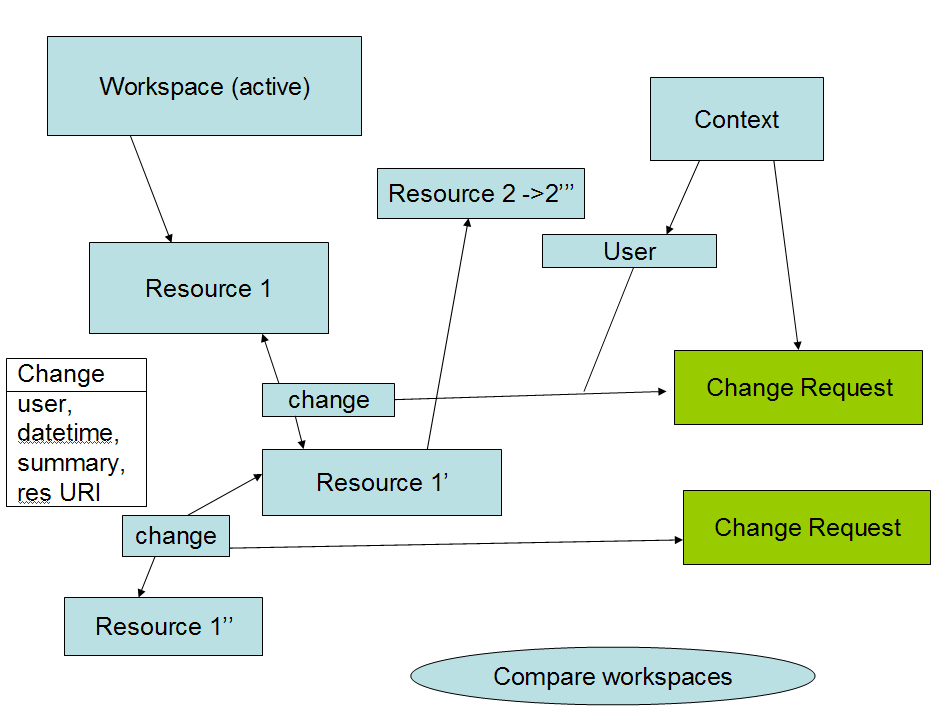This wiki is locked. Future workgroup activity and specification development must take place at our new wiki. For more information, see this blog post about the new governance model and this post about changes to the website.
Date: 2 Sep 2010
Time: 7:00 AM Pacific, 10:00 AM Eastern, 3:00 PM UK, 4:00 PM Frankfurt, 5:00 PM Haifa
Call In Number: (emailed)
Participation request: contact JimConallen
Resource: a 'thing' that is managed by an AM proider. In the AM space resources are highly fragmented, and have many relationships (properties) to other resources. Rendering a resource is often an act of assembling information from all the connecting resources (and beyond). A resource has a perma link URI. Resources do not have individual versions, rather they are part of a baseline or workspace.
Baseline: a frozen set of resources that are interelated and compatible with each other. A baseline is identified with name and URI. A baseline can be derived from another (previous) baseline.
Workspace: an active set of potentially changing resources. A workspace can be derived from a baseline. It has a name and URI. A workspace can be frozen and turned into a baseline.
Change: a resource that identifies a change in a resource. Its properties include a reference to the changes resource, date/time and user that made the change. It has a reference to a change management request (uri). It also can provide a summary of the change (i.e. a textual summary).
Rendering: a resource or set of resources are displayed in a domain relavant form. This form may be a diagram, table, or textual display that uses resources properties, and the properties of related resources and system properties/settings (even from those not explicitly mentioned in the original set of resources).
Some other axioms:
Outstanding issues/questions:
Time: 7:00 AM Pacific, 10:00 AM Eastern, 3:00 PM UK, 4:00 PM Frankfurt, 5:00 PM Haifa
Call In Number: (emailed)
Participation request: contact JimConallen
Agenda
- Lets officially enter finalization, and focus on contributions to next version of specification
- Topics to consider (and reconsider) for open discussion:
- baselines
- impact analysis
- defining ontologies (to support resource analysis)
- rdf mappings to common architecture resources (i.e. UML, BPMN, ...)
- Jim will provide an update on core activities and recent discussions on linking and query
Minutes
Atendees: Jim Conallen, John Crouchley, Tom Piccoli, Sandeep Kholi, Clyde D. Icuspit Regrets: Jim Amsden, Brenda Ellis, Scott Boswort, Bob Maksimchuk- Jim gave an overiew of current linking in core, and current limitations on simple query when it comes to leveraging properties on links.
- The team continued an older discussion of the change scenario that Tom offered. We think we have a solid understanding of the following concepts:
Resource: a 'thing' that is managed by an AM proider. In the AM space resources are highly fragmented, and have many relationships (properties) to other resources. Rendering a resource is often an act of assembling information from all the connecting resources (and beyond). A resource has a perma link URI. Resources do not have individual versions, rather they are part of a baseline or workspace.
Baseline: a frozen set of resources that are interelated and compatible with each other. A baseline is identified with name and URI. A baseline can be derived from another (previous) baseline.
Workspace: an active set of potentially changing resources. A workspace can be derived from a baseline. It has a name and URI. A workspace can be frozen and turned into a baseline.
Change: a resource that identifies a change in a resource. Its properties include a reference to the changes resource, date/time and user that made the change. It has a reference to a change management request (uri). It also can provide a summary of the change (i.e. a textual summary).
Rendering: a resource or set of resources are displayed in a domain relavant form. This form may be a diagram, table, or textual display that uses resources properties, and the properties of related resources and system properties/settings (even from those not explicitly mentioned in the original set of resources).
Some other axioms:
- A resource can only be rendered in the context of a baseline or workspace (since it requires the assembly a many individual resources).
- The same URI can't exist in two different workspaces.
- You can always do a GET on a resource URI and it should return the OSLC AM representation, or if HTML accept headers are used, a web based rendering of the resource.
Outstanding issues/questions:
- Can the same URI can exist in two different baselines? If so what is returned on a GET?
- Can we create more than one workspace from a baseline? If so how do we reconcile the URIs?

| I | Attachment | Action | Size | Date | Who | Comment |
|---|---|---|---|---|---|---|
| |
AmWorkingDocument.png | manage | 37.4 K | 02 Sep 2010 - 16:59 | JimConallen |
Topic revision: r3 - 02 Sep 2010 - 17:00:43 - JimConallen
Contributions are governed by our Terms of Use
Ideas, requests, problems regarding this site? Send feedback

